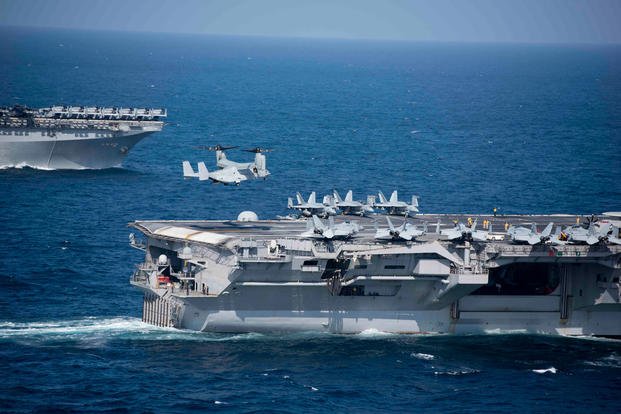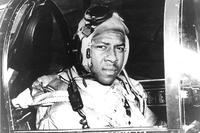About 5,000 sailors and Marines will return to California this week after spending seven busy months at sea, during which the F-35B Joint Strike Fighter carried out its first-ever combat missions.
The Essex Amphibious Ready Group and the 13th Marine Expeditionary Unit just wrapped up a deployment through Asia, the Mediterranean and the Middle East. The sailors and Marines were prepared to respond to crises that broke out in all three of the regions while supporting combat operations in Syria, Iraq and Afghanistan.
"This is the most dynamic MEU that I've seen in a long time," Col. Chandler Nelms, the MEU's commanding officer, told Military.com last week. "We've been postured for crisis response every single day of the deployment. We've been watching what's been going on around the world and had forces trained and ready to respond."
The three-ship ARG included the amphibious assault ship Essex, amphibious transport dock Anchorage and dock landing ship Rushmore. The MEU was made up of the F-35 detachment from Marine Fighter Attack Squadron 211; Battalion Landing Team 3rd Battalion, 1st Marines; Combat Logistics Battalion 13; Marine Medium Tiltrotor Squadron 166; and a command element.
Related content:
- Marine F-35s Dropped a Bunch of Bombs on ISIS During 1st Middle East Deployment
- Combat Debut: Marines' F-35B Strikes Taliban Target in Afghanistan
- Marine Lost Overboard from Amphibious Ship Identified as Helicopter Crew Chief
Throughout the deployment, the sailors and Marines trained with troops from Indonesia, Malaysia, Sri Lanka, India and Italy, and coalition forces operating in the Middle East. Nelms said they launched aircraft from the ship daily. Marines flew a CH-53E Super Stallion heavy-lift helicopter into Iraq, and an artillery battery pushed into Syria with M777 howitzers.
"It has just been a really dynamic deployment, and the Marines and sailors performed exceptionally well," Nelms said.
While in the Persian Gulf, the team encountered Iranian fast-attack craft, said Navy Capt. Gerald Olin, the ARG/MEU's commodore and commander of Amphibious Squadron 1. In October, a pair of fast boats got within about 300 yards of the Essex when Army Gen. Joseph Votel, head of U.S. Central Command, was aboard the ship.
There were no signs of hostile intent during any of the encounters, according to Olin, who said the run-ins are not uncommon.
"The danger in that is that you have to be alert and not become complacent or get too used to it," he said. "You need to keep your guard up."
Shortly after the ARG/MEU got underway in July, Cpl. Jonathan Currier, a CH-53E crew chief, was reported missing near the Philippines. A massive search-and-rescue mission that covered about 13,000 miles was eventually called off.
The Marines and sailors held a memorial service for Currier on the Essex earlier this month.
"It's always sad to lose one of our own on a deployment," Nelms told Military.com in September. "It's extremely hard for the team and our hearts are going out to the Curriers as we've gone through this really sad tragedy."
-- Gina Harkins can be reached at gina.harkins@military.com. Follow her on Twitter @ginaaharkins.













